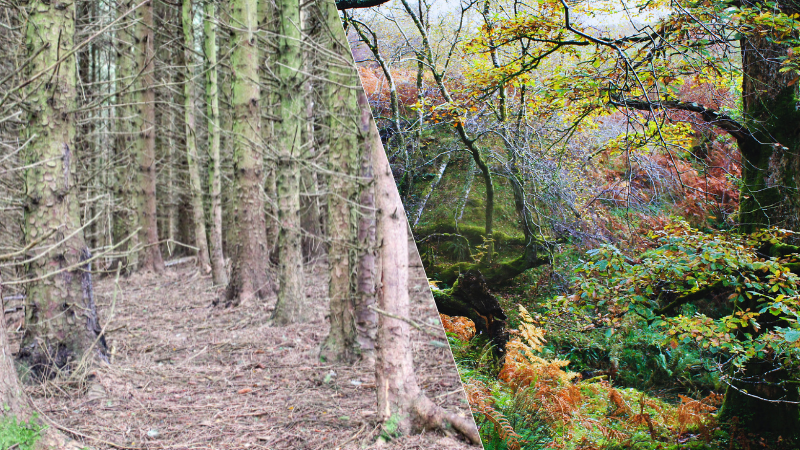Which Woodland: A Clear Choice for Biodiversity

There’s no denying that England needs timber, and therefore timber plantations. But currently many of these plantations are situated on top of one of our rarest and most valuable ecosystems; ancient woodlands. Like the disastrous impact draining peatlands for plantations, emitting tons of carbon dioxide into the atmosphere in the process, plantations on ancient woodland sites (or Ghost Woods) have catastrophic impacts on biodiversity.
Timber plantations in the UK vary significantly, from dark block conifer stands of spruce, pine, fir, or Western Hemlock, to native trees such as beech. However, what they all share is a lack of diversity, with the majority made up of a monoculture crop of a single species of tree. These monocultures shade out the light-loving native woodland plants, leaving the understory devoid of life. Crucially, these woodlands also lack a diversity of age, including deadwood which is vital for a range of ecological processes and species – around 30% of woodland species rely on deadwood for their survival!
On the other hand, ancient woodlands support a wide variety of species not found in any other ecosystem. On top of the enormous biodiversity above ground, the soils in ancient woodlands are key for natural ecological processes such as decomposition and nutrient cycling. They also punch well above their weight in terms of carbon sequestration, accounting for 36% of all woodland carbon storage despite being only 24% of England’s woodlands.
Unfortunately, our ancient woodlands are fragile environments which have been pushed to the limit through fragmentation, overgrazing by deer and other animals, and being cut down to grow timber plantations. Most of the incredible array of herbaceous ancient woodland plants, like bluebells, wood anemone, lily of the valley, are very slow colonisers. This means that they spread very slowly, and are often unable to cope with disturbances such as woodland clearance or changes in tree cover, such as with plantations. The soil biome is also interrupted when plantations are erected as the conifers shade out the soil and start to change its pH levels through their acid needles. The soil of ancient woodlands is also an important carbon store which, when clear-felled, can release carbon into the atmosphere.
The importance of restoring our Ghost Woods is never more obvious than when the abundance of our ancient woodlands are contrasted with the silence of our timber plantations.
Monocultures, like many of our Ghost Woods, are particularly susceptible to being knocked out by disease as they are close together and usually don’t have a lot of genetic or age diversity. Drought and flooding associated with climate change are also causing issues, making these crops less financially viable. When it comes to our Ghost Woods, we need to rethink the way we grow trees for timber – protecting our precious habitats and ensuring that we are able to provide sustainable, viable timber for our local communities and country.
As each cycle of felling in plantations arises, there comes a clear choice: to prioritise fast growing timber which holds less power for nature, or to restore our woodlands to a more natural state, with the ecological resilience which this affords. In the current biodiversity crisis, we know which option we would choose.
Our blog posts are written by our core team and guest bloggers. If you have an idea for a blog post please pitch it to us: info@wildcard.land
ARCHIVES
- May 2025
- April 2025
- March 2025
- February 2025
- December 2024
- November 2024
- October 2024
- September 2024
- August 2024
- July 2024
- June 2024
- March 2024
- February 2024
- January 2024
- December 2023
- November 2023
- August 2023
- July 2023
- May 2023
- February 2023
- January 2023
